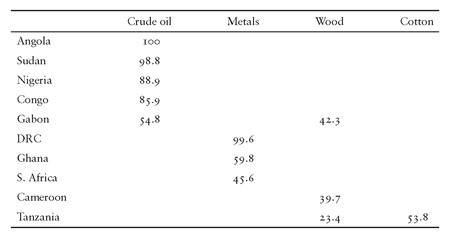
Table 3. China’s percentage share of certain commodities exported by African states.
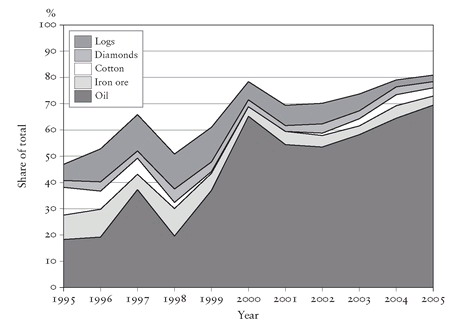
Figure 34. Composition of Chinese imports from sub-Saharan Africa.
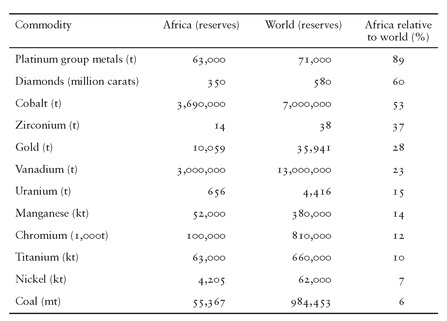
Table 4. Africa’s mineral reserves versus world reserves.
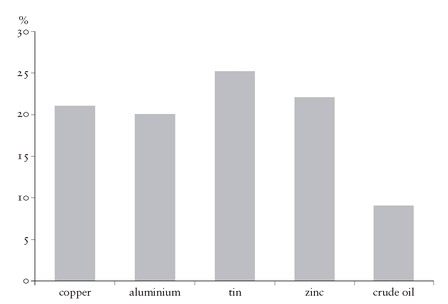
Figure 35. Chinese share of global consumption of commodities in 2006.
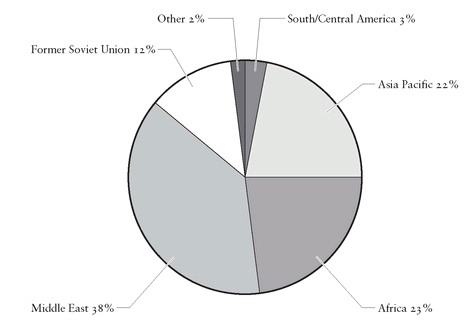
Figure 36. Where does China get its oil from?
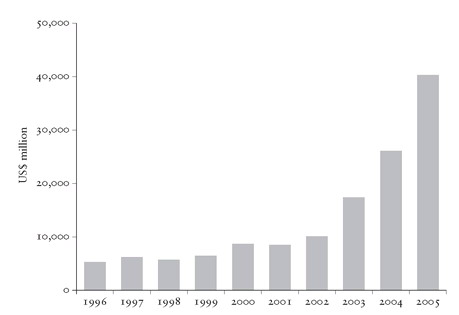
Figure 37. Rapid growth of China’s trade with Africa.

Figure 38. Foreign direct investors in sub-Saharan Africa.
Oil now accounts for over half of African exports to China, [1046] with Angola having replaced Saudi Arabia as the country’s largest single oil provider, supplying 15 per cent of all its oil imports. [1047] China has oil interests in Algeria, Angola, Chad, Sudan, Equatorial Guinea, Congo and Nigeria, including substantial exploration rights, notably in Angola, Sudan and Nigeria. Sudan exports half of its oil to China, representing 5 per cent of the latter’s total oil needs. [1048] Already over 31 per cent of all China’s oil imports come from Africa and that is set to rise with the purchase of significant stakes in Nigeria’s delta region. [1049] Over the past decade, China’s imports in all the major primary commodity categories, except ores and metals, grew much more rapidly from Africa than from the rest of the world. Africa now accounts for a massive 20 per cent of China’s total timber imports. [1050] China has overtaken the UK to become Africa’s third most important trading partner after the United States and France, though Africa still accounts for only 3 per cent of total Chinese trade. [1051] While the value of US-Africa trade in 2006 was $71.1 billion, China-Africa trade is rapidly closing the gap at $50.5 billion. [1052] With 80 °China-financed projects, valued at around $1.25 billion in 2005 — before the 2006 conference — Chinese investment in Africa still accounts for only around 1 per cent of total foreign investments in Africa, but future projections suggest that China will very soon become one of the three top investors in the continent after France and the UK. [1053] It seems only a matter of time before China becomes Africa’s largest trading partner and its biggest source of foreign investment, probably by a wide margin, though India may one day emerge as a serious competitor.
The evidence of the growing Chinese presence in Africa is everywhere: Chinese stallholders in Zambia, Chinese lumberjacks in the Central African Republic, Chinese tourists in Zimbabwe, Chinese newspapers in South Africa, Chinese geologists in Sudan, Chinese channels on African satellite television. [1054] There are estimated to be over 900 large- and medium-sized Chinese companies now operating in Africa, [1055] together with a vast number of small-scale entrepreneurs, especially in the retail trade. Chinese shops, in particular, have proliferated with great speed, at times causing considerable alarm in the local African population: in Oshikango, Namibia, for example, the first shop was opened in 1999, by 2004 there were twenty-two shops, and by 2006 no less than seventy-five. In the Senegalese capital Dakar an entire city boulevard, a stretch of about a kilometre, is lined with Chinese shops selling imported women’s shoes, consumer durables such as glassware, and electronic goods at rock-bottom prices. [1056] The rapidly growing number of direct flights between China and Africa are packed with Chinese businessmen, experts and construction workers; in contrast, there are few direct flights between Africa and the US, and the passengers are primarily aid workers with a smattering of tourists and businesspeople. [1057] The Chinese population in Africa has increased rapidly. It is estimated that it numbered 137,000 in 2001 but by 2007 had grown to over 400,000, compared with around 100,000 Western expatriates, and even this could be a serious underestimate. [1058] A more generous estimate, based on Table 5, suggests a Chinese population of over 500,000, but this is excluding Angola, where the figure is estimated at 40,000, and various other countries as well. [1059] The present wave of Chinese migration is very different from earlier phases in the late nineteenth century and in the 1950s and 1960s. Apart from being on a much greater scale, the migrants now originate from all over China, rather than mainly from the south and east, and comprise a multitude of backgrounds, with many seemingly intent on permanent residence; the process, furthermore, is receiving the active encouragement of the Chinese government. [1060] The burgeoning Chinese population is matched by a growing number of prosperous middle-class Chinese tourists. Tourism accounts for a substantial part of foreign exchange receipts in some African countries like Kenya and the Gambia, and it is anticipated that there will be 100 million Chinese tourists annually visiting Africa in the near future. [1061] An ambitious tourism complex, for example, on Lumley Beach in Freetown, Sierra Leone — not one of the countries where Chinese influence is most pronounced — is in the pipeline, with an artist’s impression in the Ministry of Tourism showing pagoda-style apartments and Chinese tourists strolling around a central fountain. [1062] A further significant illustration of the expanding Chinese presence in Africa is the growing contingent of Chinese troops involved in UN peacekeeping operations. In April 2002 there were only 11 °Chinese personnel worldwide but by April 2006 this had grown to 1,271 (with China rising from 46th to 14th in the international country ranking): revealingly, around 80 per cent of these troops are in Africa, placing it well above countries such as the UK, US, France and Germany. [1063] In total, over 3,00 °Chinese peace-keeping troops have participated in seven UN missions in Africa. [1064]
China’s impact on Africa has so far, it would appear, been positive. [1065] First, it has driven up both demand and prices for those many African countries that are commodity exporters, at least until the onset of the global downturn. Sub-Saharan Africa’s GDP increased by an average of 4.4 % in 2001-4, 5–6% in 2005-6, and a projected 7 % in 2007, compared with 2.6 % in 1999–2001, [1066] with China clearly the major factor since it has accounted for most of the increase in the global consumption of commodities since 1998. [1067] In addition, the growing availability of cheap Chinese manufactured goods has had a beneficial effect for consumers. [1068] The losers have been those countries that are not commodity exporters or those producers — as in South Africa, Kenya and Mauritius, for instance — which compete with Chinese manufacturing exports. [1069] Chinese textile exports have led to many redundancies in various African nations, notably South Africa, Lesotho and Kenya. [1070] Overall, however, there have been a lot more winners than losers. Second, China ’s arrival as an alternative source of trade, aid and investment has created a competitive environment for African states where they are no longer simply dependent on Western nations, the IMF and the World Bank. The most dramatic illustration of this has been Angola, which was able to break off negotiations with the IMF in 2007 when China offered it a loan on more favourable terms. [1071] China ’s involvement thus has had the effect of boosting the strategic importance of Africa in the world economy. [1072] Third, Chinese assistance tends to come in the form of a package, including important infrastructural projects like roads, railways and major public buildings, as well as the provision of technical expertise. [1073] (In contrast, most Western investment in Africa is concentrated in oil and other commodities and lacks the infrastructural dimension.) Fourth, Chinese aid has far fewer strings attached than that of Western nations and institutions. While the IMF and the World Bank have insisted, in accord with their ideological agenda, on the liberalization of foreign trade, privatization and a reduced role for the state, the Chinese stance is far less restrictive. [1074] In addition, the West frequently attaches political conditions concerning democracy and human rights while the Chinese insist on no such conditionality. This conforms to the Chinese emphasis on respect for sovereignty, which they regard as the most important principle in international law and which is directly related to their own historical experience during the ‘century of humiliation’. In April 2006, in an address to the Nigerian National Assembly, Hu Jintao declared: ‘ China steadfastly supports the wish of the African countries to safeguard their independence and sovereignty and choose their roads of development according to their national conditions.’ [1075]
[1046] Daniel Large, ‘As the Beginning Ends: China ’s Return to Africa ’, in Manji and Marks, African Perspectives on China in Africa, p. 158.
[1047] Barry Sautman and Yan Hairong, ‘Honour and Shame? China ’s Africa Ties in Comparative Context’, in Leni Wild and David Mepham, eds, The New Sinosphere (London: Institute for Public Policy Research, 2006), p. 54; Chris Alden, China in Africa (London: Zed Books, 2007), p. 67.
[1048] Ndubisi Obiorah, ‘Who’s Afraid of China in Africa? Towards an African Civil Society Perspective on China-Africa Relations’, in Manji and Marks, African Perspectives on China in Africa , pp. 47- 8.
[1050] John Rocha, ‘A New Frontier in the Exploitation of Africa’s Natural Resources: The Emergence of China’, in Manji and Marks, African Perspectives on China in Africa, p. 22.
[1051] Leni Wild and David Mepham, introduction in Wild and Mepham, The New Sinosphere, p. 2.
[1054] John Blessing Karumbidza, ‘Win-Win Economic Co-operation: Can China Save Zimbabwe’s Economy?’, in Manji and Marks, African Perspectives on China in Africa, p. 89.
[1055] Alden, China in Africa, pp. 14, 39–40; Kitissou, Africa in China’s Global Strategy, p. 171.
[1056] Alden, China in Africa, p. 49; ‘A Troubled Frontier: Chinese Migrants in Senegal ’, South China Morning Post, 17 January 2008.
[1057] Howard W. French, ‘Chinese See a Continent Rich with Possibilities’, International Herald Tribune, 15 June 2007.
[1061] Abah Ofon, ‘South-South Co-operation: Can Africa Thrive with Chinese Investment? ’, in Wild and Mepham, The New Sinosphere, p. 27.
[1062] Lindsey Hilsum, ‘ China, Africa and the G8 — or Why Bob Geldof Needs to Wake Up’, in Wild and Mepham, The New Sinosphere, pp. 6–7.
[1063] Mark Curtis and Claire Hickson, ‘Arming and Alarming? Arms Exports, Peace and Security’, in Wild and Mepham, The New Sinosphere, p. 41.
[1065] Interview with Jeffrey Sachs, ‘ Africa ’s Long Road Out of Poverty’, International Herald Tribune, 11 April 2007.
[1066] Marks, introduction in Manji and Marks, African Perspectives on China in Africa, p. 5.
[1067] Raphael Kaplinsky, ‘Winners and Losers: China ’s Trade Threats and Opportunities for Africa ’, in Wild and Mepham, The New Sinosphere, p. 16.